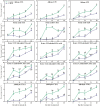Effect of 1-methylcyclopropene on peel greasiness, yellowing, and related gene expression in postharvest 'Yuluxiang' pear
- PMID: 36714764
- PMCID: PMC9878607
- DOI: 10.3389/fpls.2022.1082041
Effect of 1-methylcyclopropene on peel greasiness, yellowing, and related gene expression in postharvest 'Yuluxiang' pear
Abstract
'Yuluxiang' pear (Pyrus sinkiangensis) commonly develop a greasy coating and yellowing during storage. In this study, 1.0 μL L-1 1-methylcyclopropene (1-MCP) was applied to 'Yuluxiang' pear to investigate its effects on fruit quality, peel wax composition, greasiness index, chlorophyll content, and the expression pattern of related genes during storage at ambient temperature (25°C). The results showed that 1-MCP treatment maintained higher fruit firmness and chlorophyll content, decreased respiration rate, and postponed the peak of ethylene production rate, lowered the greasy index of the peel. The main wax components of peel accumulated during storage, the principal ones being alkenes (C23, C25, and C29), fatty acids (C16, C18:1, and C28), aldehydes (C24:1, C26:1, and C28:1), and esters (C22:1 fatty alcohol-C16 fatty acid, C22:1 fatty alcohol-C18:1 fatty acid, C22 fatty alcohol-C16 fatty acid, C22 fatty alcohol-C18:1 fatty acid, C24:1 fatty alcohol-C18:1 fatty acid, and C24 fatty alcohol-C18:1 fatty acid), and were reduced by 1-MCP. 1-MCP also decreased the expression of genes associated with ethylene biosynthesis and signal transduction (ACS1, ACO1, ERS1, ETR2, and ERF1), chlorophyll breakdown (NYC1, NOL, PAO, PPH, and SGR), and wax accumulation (LACS1, LACS6, KCS1, KCS2, KCS4, KCS10L, KCS11L, KCS20, FDH, CER10, KCR1, ABCG11L, ABCG12, ABCG21L, LTPG1, LTP4, CAC3, CAC3L, and DGAT1L). There were close relationships among wax components (alkanes, alkenes, fatty acids, esters, and aldehydes), chlorophyll content, greasiness index, and level of expression of genes associated with wax synthesis and chlorophyll breakdown. These results suggest that 1-MCP treatment decreased the wax content of 'Yuluxiang' pear and delayed the development of peel greasiness and yellowing by inhibiting the expression of genes related to the ethylene synthesis, signal transduction, wax synthesis, and chlorophyll degradation.
Keywords: chlorophyll; ethylene; gene expression; greasiness; pear; wax.
Copyright © 2023 Li, Li, Cheng and Guan.
Conflict of interest statement
The authors declare that the research was conducted in the absence of any commercial or financial relationships that could be construed as a potential conflict of interest.
Figures









References
-
- Cheng Y., Dong Y., Yan H., Ge W., Shen C., Guan J., et al. . (2012). Effects of 1-MCP on chlorophll degradation pathway-associated genes expression and chloroplast ultrastructure during the peel yellowing of Chinese pear fruits in storage. Food Chem. 135, 415–422. doi: 10.1016/j.foodchem.2012.05.017 - DOI - PubMed
-
- Cheng Y., Guan J. (2014). Involvement of pheophytinase in ethylene-mediated chlorophylldegradation in the peel of harvested ‘Yali’pear. J. Plant Growth Regul. 33, 364–372. doi: 10.1007/s00344-013-9383-z - DOI
-
- Christeller J. T., Roughan P. G. (2016). The novel esters farnesyl oleate and farnesyl linoleate are prominent in the surface wax of greasy apple fruit. New Zeal. J. Crop Hortic. 4, 164–170. doi: 10.1080/01140671.2016.1152979 - DOI
LinkOut - more resources
Full Text Sources
Miscellaneous

